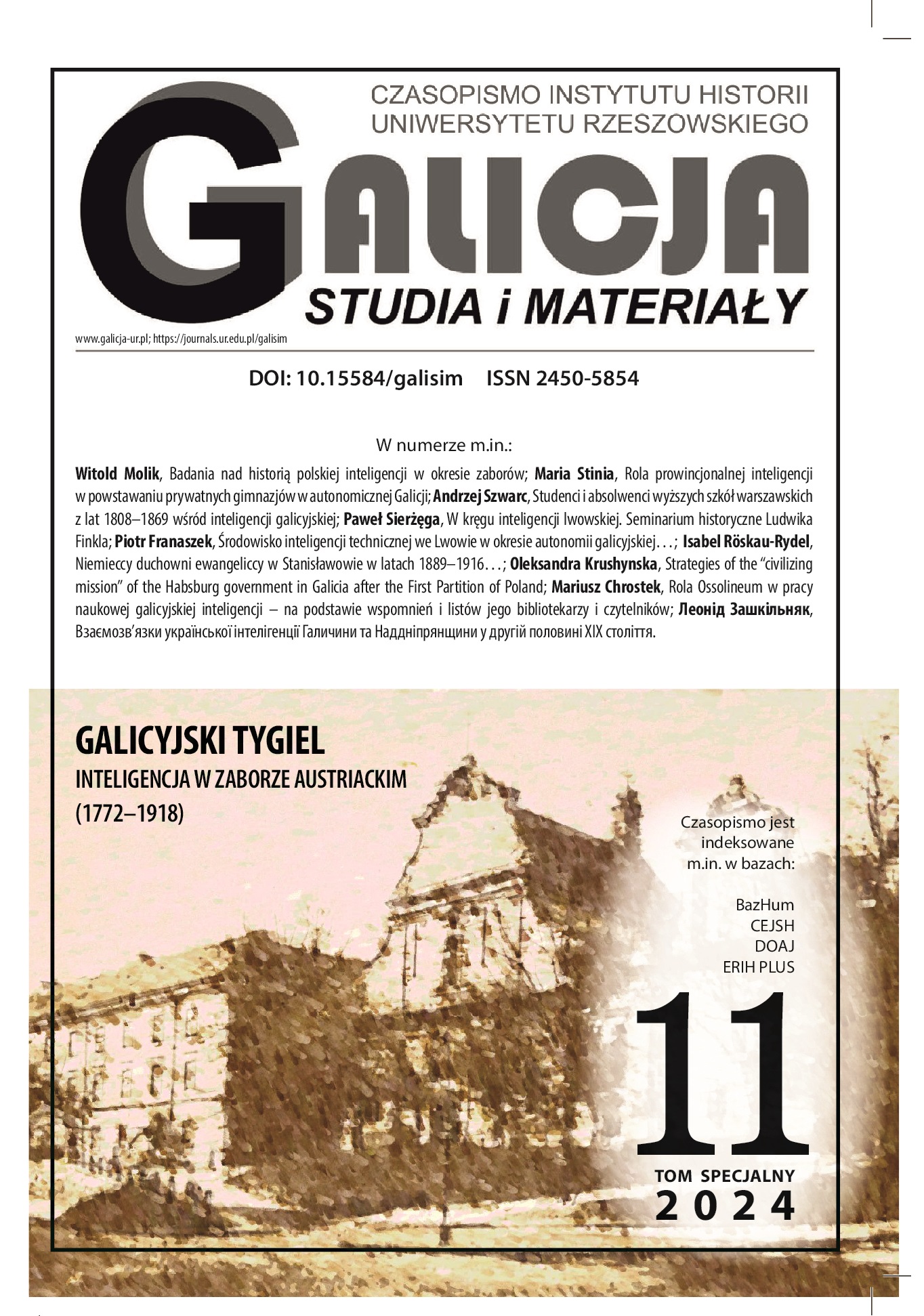Josephine reorganisation of magistrates in Galicia as a factor in the formation of a new urban clerical elite
DOI:
https://doi.org/10.15584/galisim.2024.11.16Keywords:
Galicia, cities, magistrate, officials, urban eliteAbstract
The article discusses the implementation and effects of the reform of the urban system in Galicia at the turn of the 18th and 19th centuries, including in particular the problem of the creation of regulated magistracies and the formation of a new urban clerical elite. The reforms initiated during the reign of Emperor Joseph II led to the abolition of the former municipal self-government, transforming the regulated magistrates into the lowest organ of state and judicial administration. By 1820, municipal executives organised under the new rules had been established in only 63 of Galicia's nearly 300 cities. In the long term, this led, on the one hand, to a radical reduction in the influence of the bourgeoisie on city management and, on the other hand, to the formation of new elites, which to a large extent no longer came from local backgrounds, as in the case of the old municipal government, but which were formed by the incoming population members.
Downloads
References
Centralne Państwowe Archiwum Historyczne Ukrainy we Lwowie fond 146: Namiestnictwo Galicyjskie, opis 78 sprawy 32, 100, 113, 170, 277, 295, 378, 379; opis 88 sprawy 188, 189
Państwowe Archiwum Lwowskiej Obłasti fond 26: Uniwersytet im. Jana Kazimierza we Lwowie, opis 4 sprawa 283
Continuatio editorum, mandatorum et universalium in Regnis Galiciae et Lodomeriae, Leopoli 1786, 1790, 1791, 1793, 1794, 1795
Schematismus des Königreiches Galizien und Lodomerien für das Jahr 1820, 1823, Lemberg 1820, 1823
At the Meeting Point of Cultures and Nations. Galician Towns and Small Towns in the Josephinian Cadastral Survey. A Collection of Studies, ed. B. Petryshak, T. Kargol and K. Ślusarek, Kraków–Lviv 2020.
Balzer O., Historia ustroju Austrii w zarysie, Lwów 1899.
Czołowski A., Pogląd na organizację i działalność dawnych władz miejskich do 1848 r. [w:] Miasto Lwów w okresie samorządu 1870–1895, Lwów 1896, s. I–LXXXIV.
Dolinowśkyj W., Ślusarek K., Misto czy seło? Ekonomicznyj obraz mist i misteczok schidnoji czastyny Hałyczyny naprykinci XVIII – na poczatku XIX stolittia, Krakiw–Kyjiw 2023.
Glassl H., Das österreichische Einrichtungswerk in Galizien 1772–1790, Wiesbaden 1975.
Jewuła Ł., Galicyjskie miasta i miasteczka oraz ich mieszkańcy w latach 1772–1848, Kraków 2013.
Karpiniec J., Ilość osad miejskich byłej Galicji i ich podział na miasta i miasteczka, „Roczniki Dziejów Społecznych i Gospodarczych”, t. II: 1932 i 1933, Lwów 1932, s. 1–29.
Miasta i miasteczka wschodniej części Galicji pod koniec XVIII wieku, t. 1–7, Kraków–Lwów 2020.
Na styku kultur i narodów. Galicyjskie miasta i miasteczka w józefińskim katastrze gruntowym, red. nauk. K. Ślusarek, t. 1–48, Kraków 2018–2020.
Petryszak B., Zminy w strukturi ta funkcionuwanni miśkoji włady w Hałyczyni naprykinci XVIII stolittia [w:] Miasta i miasteczka wschodniej części Galicji pod koniec XVIII wieku, t. I: Władza i społeczeństwo, s. 26–37.
Ślusarek K., Czy u schyłku XVIII wieku miasta leżące w najdalej na wschód wysuniętej części Galicji rzeczywiście były miastami?, „Kwartalnik Historyczny” 2022, R. CXXIX, z. 3, s. 659–675.
Ślusarek K., Miasta i miasteczka wschodniej części Galicji pod koniec XVIII wieku, t. IV: Typologia funkcjonalna miast Galicji, Kraków–Lwów 2020.
Tokarz W., Galicja w początkach ery józefińskiej w świetle ankiety urzędowej z roku 1783, Kraków 1909.
Downloads
Published
How to Cite
Issue
Section
License
Copyright (c) 2024 Galicja.Studia i materiały

This work is licensed under a Creative Commons Attribution-NonCommercial-NoDerivatives 4.0 International License.



